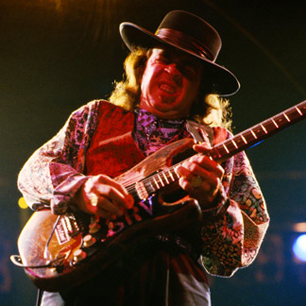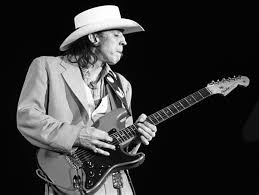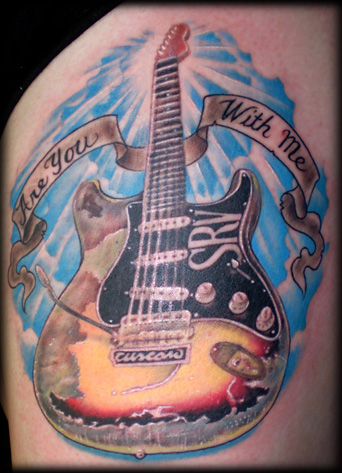
Stevie Ray Vaughan (SRV) remains a towering figure in blues-rock, his searing Stratocaster tone immortalized in tracks like “Pride and Joy” and “Texas Flood.” For guitarists in their 40s to 60s, who grew up with SRV’s electrifying performances and the golden era of guitar-driven music, capturing his soulful, gritty sound is a dream. Achieving the Stevie Ray Vaughan tone requires a blend of the right gear, meticulous setup, and a deep understanding of his technique, all infused with passion.
Why the Stevie Ray Vaughan Tone Still Resonates Today
SRV’s tone is a perfect storm of raw emotion, technical brilliance, and vintage gear, blending the warmth of Fender amps with the bite of overdriven Marshalls. His sound, rooted in the blues of Albert King and Jimi Hendrix yet distinctly his own, continues to inspire players in 2025. For adults revisiting the music of their youth, SRV’s tone evokes nostalgia for the 1980s, when his Stratocaster wailed through smoky clubs and MTV airwaves. But replicating it isn’t just about gear—it’s about channeling the feel and dynamics that made SRV a legend. This guide breaks down the process into 10 actionable steps, from guitars to mindset, ensuring you can get close to his sound without breaking the bank.
10 Steps to Master Stevie Ray Vaughan’s Tone
1. Choose the Right Guitar: The Fender Stratocaster
SRV’s primary weapon was his 1959 Fender Stratocaster, “Number One,” a battle-worn instrument with a sunburst finish and a 1957 “D”-shaped neck. He also used other Strats, like “Lenny” and “Scotch,” all featuring vintage-style single-coil pickups for that glassy, bell-like tone. To emulate SRV:
- Guitar Choice: A Fender Stratocaster is ideal, but budget-friendly options like the Fender Player Series Stratocaster ($700–$800) or Squier Classic Vibe ’60s Stratocaster ($400) deliver authentic tones. Look for rosewood fretboards for warmth, though maple works for brighter sounds.
- Pickups: Vintage-style single-coils, like Seymour Duncan SSL-1 or Fender Custom Shop ’59, mimic SRV’s chimey, dynamic sound. Avoid hot pickups, which can sound too aggressive.
- Neck Setup: SRV’s “Number One” had a thick “D” profile, refretted with jumbo frets to handle his heavy strings and aggressive bending. Set your guitar with medium-high action (2–2.5mm at the 12th fret) for better sustain and bending, but ensure it’s playable. A luthier can refret with jumbo frets for $200–$300.
- Unique Features: SRV’s left-handed tremolo on “Number One” subtly altered his tone due to the tremolo block’s orientation. While not essential, a left-handed tremolo kit ($50) can add authenticity. The worn neck, smoothed from years of play, enhanced fluidity—sanding the back of a new neck lightly can mimic this.
Tip: Use your guitar’s volume and tone knobs dynamically, as SRV did, rolling back volume for cleaner sounds or boosting tone for solos. A 2025 Guitarist review praises the Squier Classic Vibe for its “SRV-esque clarity,” making it a great starting point.
2. Use Heavy Strings for Power
SRV’s heavy string gauges (.013–.058, sometimes .011–.052) were key to his thick, singing tone, though they challenged his fingers, often requiring “Crazy Glue” to seal cuts. Heavy strings offer richer tone and better sustain but demand strength.
- String Choice: Start with D’Addario NYXL .011–.052 for a balance of SRV’s tone and playability. If you’re ready for his full setup, try .013–.058, but build finger strength gradually.
- Tuning: SRV tuned down a half-step (Eb Ab Db Gb Bb Eb) for a slinkier feel and deeper tone. Use a chromatic tuner to ensure accuracy.
- Setup Adjustments: Heavy strings require a truss rod tweak and nut filing to avoid buzzing. A professional setup ($50–$100) ensures proper intonation, critical for SRV’s big bends. Premier Guitar notes that heavier strings “unlock SRV’s vocal-like sustain.”
Caution: Consult a luthier when switching to heavier gauges, as your guitar’s nut may need replacement to accommodate them.
3. Dial In the Amplifiers
SRV’s amp setup was a cornerstone of his sound, blending Fender’s sparkling cleans with Marshall’s gritty overdrive. He often daisy-chained multiple amps for a layered, full-bodied tone.
- Core Amps:
- Fender Vibroverb ’64 (15” speaker): SRV’s go-to for lush cleans and reverb, priced at $2,000 used. Budget alternative: Fender ’65 Deluxe Reverb Reissue ($1,500).
- Fender Super Reverb (4×10): Cranked for natural tube overdrive, around $1,800 used. Try the Fender Tone Master Super Reverb ($1,200) for digital versatility.
- Marshall Major (200W): Added midrange punch, rare and costly. The Marshall DSL20CR ($700) is a modern substitute.
- Dumble Steel String Singer: Ultra-clean and rare ($10,000+). The Two-Rock Studio Signature ($5,000) offers similar clarity.
- Setup: Crank amps to 7–8 for natural overdrive, with settings like Bass: 7, Mids: 8, Treble: 5–6. Use a wet/dry setup if possible, splitting your signal to a clean Fender and an overdriven Marshall via an A/B/Y splitter ($50).
- Modifications: SRV’s amps, tweaked by Cesar Diaz, had boosted gain and altered reverb. A tech can mod a Fender amp for $100–$200, but stock models work well.
Modern Tip: For 2025, compact amps like the Boss Katana-50 MkII ($250) with SRV-inspired presets offer affordable approximations, per Guitar World.
4. Perfect Your Pedalboard
SRV’s effects pedals added color to his tone, with the Ibanez Tube Screamer as the centerpiece. Here’s how to build an SRV-style board:
- Ibanez Tube Screamer (TS-808/TS-9): Essential for overdrive, set with Drive: 9 o’clock, Level: 2 o’clock, Tone: 12 o’clock. The TS808 Reissue ($180) is ideal, or try the Maxon OD808 ($150).
- Wah Pedal: A Vox V846 or Dunlop Cry Baby ($100–$150) for expressive solos, used sparingly in songs like “Say What.”
- Rotary Effect: A Fender Vibratone or Strymon Lex Rotary ($300) for the swirling sound in “Cold Shot.”
- Octave/Fuzz: The Roger Mayer Octavia or Electro-Harmonix Octave Multiplexer ($150) for “Little Wing” textures. A Dunlop Fuzz Face ($150) adds grit.
- Reverb/Delay: If your amp lacks reverb, use a TC Electronic Hall of Fame 2 ($150). Add a Boss DD-8 ($160) for subtle delay.
- Boost: A Keeley Katana Boost ($200) pushes amps into overdrive, mimicking SRV’s dynamics.
Tip: Keep pedals minimal to let your amp and guitar shine. X users in 2025 praise the TS808 for its “SRV-approved midrange boost.”
5. Master SRV’s Technique
Gear alone won’t capture SRV’s tone—his technique was the heart of his sound. Focus on these elements:
- Pick Attack: SRV’s aggressive picking, using Fender Medium picks ($5 for 12) held at the narrow end, created sharp, articulate notes. Practice digging into strings.
- Vibrato: His deep, fast vibrato added soul. Practice bending strings and shaking them rhythmically, aiming for a vocal-like quality.
- Thumb-Over Technique: SRV used his thumb to fret the low E string, freeing fingers for complex licks. Try this on chords like E7 or A7.
- Bends and Slides: His big bends (up to two steps) and occasional slide work (with a glass slide) added expressiveness. Build finger strength for control.
- Dynamics: SRV varied his picking intensity and guitar volume for clean-to-dirty transitions. Practice rolling back volume for rhythm and boosting for leads.
Expert Insight: Guitar instructor Lisa Carter says, “SRV’s tone came from his hands. Practice his vibrato and thumb-over technique daily to internalize his feel.”
6. Optimize Guitar Setup
A proper setup ensures your guitar can handle SRV’s heavy strings and aggressive style:
- Intonation: Heavy strings and big bends require precise intonation. Have a luthier check it ($50–$75), especially after changing gauges.
- Action and Relief: Set action at 2–2.5mm and add slight neck relief (.010”–.012”) to avoid fret buzz. Premier Guitar recommends professional setups for SRV-style guitars.
- Cables: SRV used coiled cables, which slightly warm the tone. Try a Fender 15’ Coiled Cable ($30) or a straight Mogami Gold ($50) for clarity.
- Tremolo: Lock the tremolo or use a Tremol-No ($70) for tuning stability, as SRV rarely used the whammy bar.
Story: Mark, a 52-year-old player, upgraded his Squier Strat with jumbo frets and .011 strings. “After a pro setup, my bends sound closer to ‘Lenny,’” he says.
7. Embrace Stage Volume
SRV played at high volumes, pushing amps into natural overdrive and creating feedback and sustain. While home practice at lower volumes works, gigging at 80–100 dB unlocks SRV’s tone:
- Volume Strategy: Use an attenuator like the Boss Waza Tube Amp Expander ($1,300) for high-volume tones at home. For gigs, crank amps to 7–8.
- Feedback Control: Position yourself near the amp to induce controlled feedback, as SRV did in live shows.
Caution: Protect your hearing with EarPeace HD earplugs ($25), as noted in 2025 Guitarist reviews.
8. Study SRV’s Influences
SRV’s tone drew from blues giants like Albert King, B.B. King, Freddie King, Jimi Hendrix, Eric Clapton, Lonnie Mack, Jimmy Reed, and Buddy Guy. Listen to:
- Albert King’s “Born Under a Bad Sign” for soulful bends.
- Hendrix’s “Little Wing” for octave textures.
- Clapton’s Cream-era “Crossroads” for creamy overdrive.
Tip: Play along with these artists to grasp SRV’s phrasing roots. A Guitar World 2025 article emphasizes, “SRV’s tone was a conversation with his heroes.”
9. Listen and Imitate SRV’s Nuances
Immersing yourself in SRV’s catalog is crucial:
- Key Albums: Study Texas Flood (1983), Couldn’t Stand the Weather (1984), and In Step (1989).
- Live Performances: Watch Live at the El Mocambo (1983) on YouTube for his dynamics and stage energy.
- Practice Tracks: Play along with “Pride and Joy” (E blues shuffle), “Lenny” (clean ballad), and “Scuttle Buttin’” (fast instrumental) to internalize his feel.
User Insight: A 48-year-old X user shared, “Jamming to ‘Cold Shot’ with a Tube Screamer helped me nail SRV’s midrange growl.”
10. Channel SRV’s Passion and Mindset
SRV’s tone wasn’t just gear—it was heart. His passion, born from years of playing in Austin clubs, infused every note. To truly capture his sound:
- Play with Emotion: Let your feelings guide your bends and vibrato, as SRV did in “Lenny.”
- Practice Consistently: Dedicate 30 minutes daily to technique, focusing on vibrato and dynamics.
- Embrace Imperfection: SRV’s worn gear and raw style weren’t perfect but were authentic. Focus on feel over precision.
Expert Quote: Luthier Mike Tran says, “SRV’s tone was 60% technique, 40% gear. His passion made the difference—gear just amplified it.”
Modern Alternatives for 2025
Not everyone can afford a vintage Strat or Dumble amp, but 2025 offers accessible options:
- Guitars: The Fender Player Plus Stratocaster ($1,000) blends vintage tone with modern playability.
- Amps: The Blackstar HT-20R MkII ($900) combines Fender cleans and Marshall grit in one unit.
- Pedals: The JHS Angry Charlie ($200) emulates Marshall tones, pairing well with a Strymon Iridium ($400) for amp modeling.
- Digital Solutions: Line 6 Helix ($1,500) or Neural DSP Quad Cortex ($1,800) offer SRV presets for home use, praised in Guitarist for “near-authentic tones.”
Challenges and Solutions
Chasing SRV’s tone has challenges:
- Cost: Vintage gear is pricey. Use budget alternatives like Squier Strats and Boss Katana amps.
- Physical Demand: Heavy strings strain fingers. Start with .010–.046 and progress to .011–.052.
- Volume: High volumes aren’t practical at home. Use attenuators or modelers like the Kemper Profiler ($1,800).
Solutions include gradual practice, professional setups, and digital tools, ensuring accessibility for all players.
Guitar Tone Tips: Top 5 Free Ways to Improve Your Guitar Tone in 2025
Market Trends and Community Insights
The guitar industry in 2025 reflects SRV’s enduring influence. Music Trades reports a 10% rise in Stratocaster sales, driven by players seeking blues-rock tones. Online platforms like YouTube and TikTok feature SRV-inspired tutorials, while X posts highlight the Tube Screamer’s “timeless SRV magic.” Supply chain issues may raise gear prices by 5–10%, per Premier Guitar, so consider buying soon.
The Path to The Stevie Ray Vaughan Tone
Mastering Stevie Ray Vaughan’s tone is a journey of gear, technique, and soul. From a Stratocaster with heavy strings to a cranked Fender Vibroverb and a Tube Screamer, the right setup lays the foundation. But it’s SRV’s aggressive pick attack, soulful vibrato, and passionate delivery that bring it to life. Whether you’re playing “Pride and Joy” in your living room or gigging in a local club, these 10 steps—rooted in SRV’s gear, influences, and mindset—will get you closer to his Texas blues sound. So, plug in, turn up, and let your Strat sing. What’s stopping you from channeling SRV’s fire? The stage is yours.





Be the first to comment